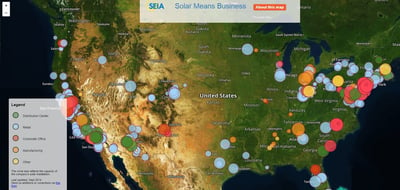 Is your state benefiting from, or missing out on, the national solar power boom that's well underway (note: click on the map to enlarge). That question is at least partly answered by the new Solar Means Business Report, released this morning by the Solar Energy Industries Association (SEIA). Among other things, the report finds that the "average price of a completed commercial [solar] PV project in Q2 2014 has dropped by 14 percent year over year and by more than 45 percent since 2012." That's great news, of course, and a continuation of the long-term trend which has seen solar power costs fall by 99% since 1977 - a trend that's continuing.
Is your state benefiting from, or missing out on, the national solar power boom that's well underway (note: click on the map to enlarge). That question is at least partly answered by the new Solar Means Business Report, released this morning by the Solar Energy Industries Association (SEIA). Among other things, the report finds that the "average price of a completed commercial [solar] PV project in Q2 2014 has dropped by 14 percent year over year and by more than 45 percent since 2012." That's great news, of course, and a continuation of the long-term trend which has seen solar power costs fall by 99% since 1977 - a trend that's continuing.
Here are a few more factoids from the SEIA report:
- "Since 2010, U.S. businesses have installed solar systems at their facilities more than 32,000 times."
- "For the second straight year, U.S. businesses, non-profits and government organizations added more than 1,000 MW of new PV solar installations. As of mid-2014, there were 4,531 MW of commercial solar PV installed on 41,803 business, non-profit and government locations throughout the U.S."
- "American businesses are turning to solar because it’s good for their bottom line. For many companies, electricity costs represent a significant operating expense, and solar provides the means to reduce costs and hedge against electricity price increases."
- "While retailers have installed the most capacity, auto manufacturers, pharmaceuticals and food servicers, as well as companies in many other industries, have all looked to solar to lower operating costs."
- "The rest of the U.S. is catching up to the likes of California and New Jersey, the first and second largest state markets for commercial solar. Leaders in those states and others like them have put in place smart, effective policies that have enabled businesses to invest in solar." Has your state put into place "smart, effective policies that have enabled businesses to invest in solar?"
- "In total, 129 million people in 33 states and Puerto Rico live within 20 miles of at least one of the 1,110 commercial solar installations that were analyzed in this report."
If that's not enough to make you wonder why your state has not seized this tremendous opportunity, see an article which just came out this morning, Georgia Is the Latest State to Procure Dirt-Cheap Solar Power, by Greentech Media. According to this article: "After a second round of bidding from developers seeking to build hundreds of megawatts' worth of solar plants in the state, Georgia Power reported that the average price of electricity came in at 6.5 cents per kilowatt-hour. That's 2 cents cheaper than last year's bids."
How cheap is 6.5 cents per kilowatt-hour? To put it in perspective, the U.S. Energy Information Administration reports that the Average Retail Price of Electricity to U.S. residential users as of July 2014 was 13.05 cents per kilowatt-hour, while the average cost to all U.S. power users was 11.01 cents per kilowatt-hour. Again, the new solar power bidding in Georgia came in at 6.5 cents per kilowatt-hour -- far lower than the national average retail price of electricity. So, if your state isn't going solar big-time, you probably should ask your state legislators and utilities why that's the case. The answer, or lack thereof, could be a real eye opener.